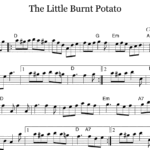Key: D
Form: Jig
ABC:
X: 8 T: The Little Burnt Potato R: jig M: 6/8 L: 1/8 K: Dmaj fg|:"D"a^ga ba^g|afd Ade|fef "G"g2f|"Em"efe Bcd|"A7"efe dcB| Ace a3|1 a^ga ba=g|"D"f3 f2g:|2 a^ga b2c|"D"d3 d2e|| |:"D"f2A f2A|f3 f2e|def agf|"Em"g3 gef|"A7"gba gfe| dcB A2a|1 a^ga ba=g|"D"f3 "A7"fde:|2 a^ga b2c|"D"d3 d||
MP3: (Played slowly for learning by Gina Fehr. See the video below for a more up-tempo ‘jiggy’ rendition.)
Download this MP3 If it plays, right-click on the page and “Save as”. (Detailed instructions for different browsers).
Sheet Music: Click image to enlarge. To download, right-click in enlarged image and "Save as...".
Sheet Music in PDF: The Little Burnt Potato
YouTube:
Source: Collin J. Boyd
Other Tunes in Set:
Region: Cape Breton*
*Notes: From the Traditional Tune Archive: “USA; New England, New York, Missouri. Canada; Maritimes, Ontario”, but to my ear it has a particularly Maritime, possibly New Brunswick, lilt.
The Traditional Tune Archive goes on to give this background on the tune’s origins: “”Little Burnt Potato” was popularized by Canadian Maritime radio and TV fiddler Don Messer. The tune has been characterized as Irish in origin, although in fact it is the composition of Canadian fiddler Colin J. Boyd, who was himself of Scottish descent. Boyd was born in West Lakeville, Nova Scotia, in 1891, and learned to play the fiddle as a child, inspired by his uncle Hughie MacGillivary. Like many in the community, he learned and spoke Gaelic. Due to a declining ecomony, Boyd found work in 1909 in Ontario, then moved to Boston for the years 1911-1916 where he studied violin and learned to read music. It was during his Boston years that he composed “Little Burnt Potato.” Boyd passed away in 1975.
“Little Burnt Potato” is Boyd’s adaptation of an old Scottish jig passed on to him by Dan “The Ridge” MacDonald, formerly of Mabou, Cape Breton, according to Mary Boyd (liner notes to Shanachie Records, CB-1). His jig proved popular and has been widely disseminated, and has been interpreted in a number of styles. It has been a staple of New England contra dances.”

